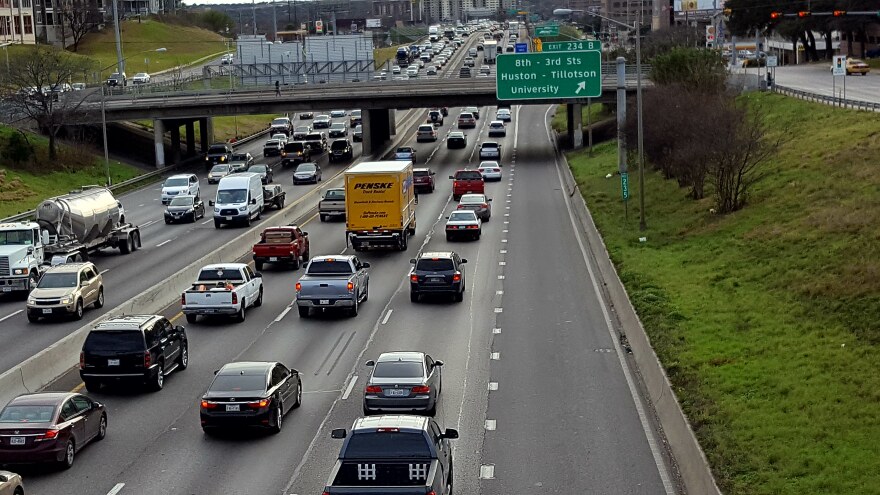
When the Lone Star Rail project fell apart last year, communities along I-35 were left looking for a new plan that would reduce travel time between San Antonio and Austin. Now, they think they’ve found one.
It’s still about rail, but the vision is bigger than San Antonio to Austin. And drivers who are “Stuck Behind the Wheel” hope it works.
There are a lot of strong words that could describe the 80 mile trip along I-35 between San Antonio and Austin.
Samantha Crawford simply calls it “miserable.”


The I-35 Nightmare
Crawford is a dental assistant who drives the stretch twice a day, five days a week to her job in Austin. On a good day she’s behind the wheel about two hours each way. Recently the trip took three hours
“It’s kind of like stop and go traffic. Through Austin I was probably going 25 miles an hour. When I first got on the highway I was probably going about 5.”
Crawford has put 250,000 miles on her car, and worries about falling asleep on the way home. But she doesn’t want to quit her job.
“If I come to San Antonio to work I’m going to take a pay cut. And my bosses are so great with my flexibility with my child it’s really not worth leaving.”
City leaders from Austin to San Antonio had hoped the Lone Star Rail project would provide an alternative for commuters like Crawford. Then, last year, Union Pacific which operates tracks along I-35 pulled out of the deal.
But San Antonio Council Member Ray Lopez wasn’t giving up. He chairs the Alamo Area Metropolitan Planning Organization which considers transportation projects for the region.
“We started a dialog with Amtrak. Would you be willing to be our new catalytic partner? The answer for them is sure.”
Amtrak Conducting Feasibility Study
Right now Amtrak operates just one daily trip each way between San Antonio and Austin. It takes about two and a half hours, which is too long to be useful to commuters.
But Amtrak confirms it is now working on a Ridership and Revenue Study at the request of the cities. By mid-year it will tell local leaders what it would cost to improve Union Pacific tracks enough, so trains could travel an average 90-miles-an-hour and provide the kind of service envisioned under Lone Star Rail.
“Which was a train leaving the station every 30 minutes during the peak hour all day long. During the non-peak hours every hour,” Lopez explains, saying the route would start in South San Antonio near the Texas A&M campus with the northern-most terminal being in Georgetown, outside of Austin.
San Antonio Mayor Ivy Taylor expects the city to spend $100,000 on the study. If the results are promising, Lopez believes the big money for the tracks and operating the trains would come mostly from private investors.
Adding High Speed Rail to Monterrey
Lopez thinks investors will be interested because there’s a vision that’s much bigger than 90-mile-an-hour passenger rail from San Antonio to Austin. It calls for the Austin-to-San Antonio line to connect in San Antonio with high speed rail that would transport passengers at 250 miles-an-hour to Laredo and on to Monterrey, Mexico.
Laredo Congressman Henry Cuellar says this isn’t just a pie in the sky day dream. Cuellar says over the past few years he’s met with Mexican officials, federal and state transportation officials, and private investors who would consider financing the project.
He says the trip from Monterrey to San Antonio would take about two hours.
“You connect San Antonio’s large population, Laredo and, of course, Monterrey with 4.5 million individuals. Entities like Sea World (in San Antonio), when I talk to them they’re all excited, because that means potentially a new base of customers.”
Lopez believes private investors will support both rail lines if they provide seamless service from Monterrey in the South to Austin in the North.
Projected Timeline
Amtrak says if all of the pieces fall into place the San Antonio to Austin service could be underway in three to five years.
Samantha Crawford says she’d be among the first to take that train.
“I would absolutely positively love to do that. I could sit on the train and read a book.”
As for the high speed route to Monterrey?
“Let me put it this way,” said Lopez. “I just turned 67, and I think I could buy a ticket in my lifetime. We could probably, within a dozen years, have the high speed rail between San Antonio and Monterrey
Lopez, in fact, says he’s headed to Japan later this month where he plans to meet with possible rail investors.



